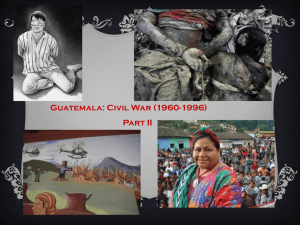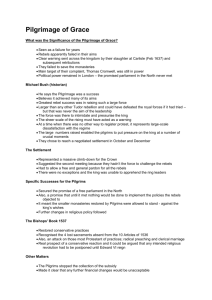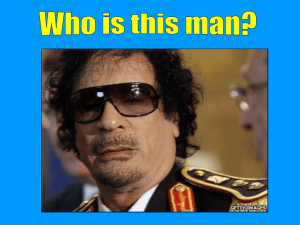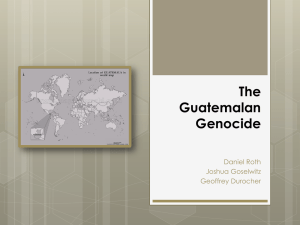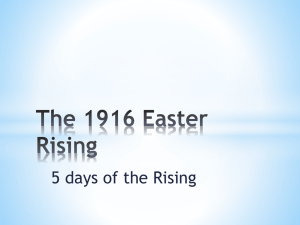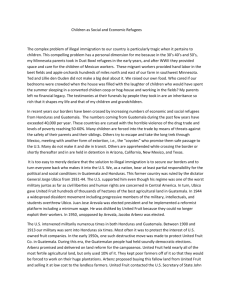Coding the Guatemalan Conflict
advertisement
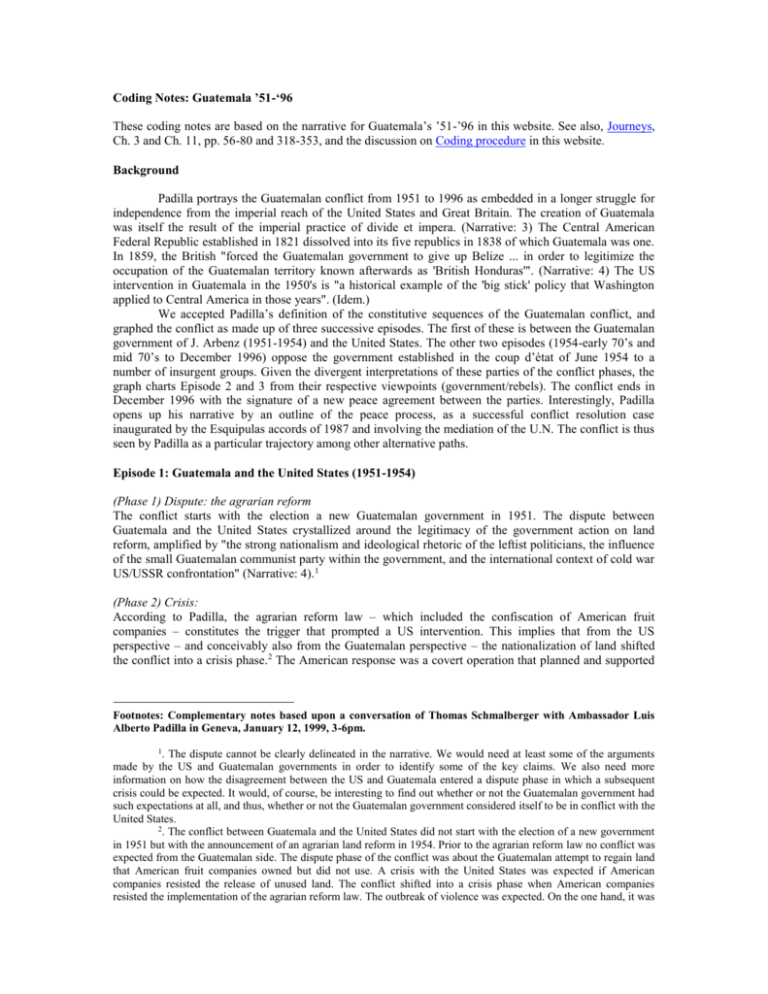
Coding Notes: Guatemala ’51-‘96 These coding notes are based on the narrative for Guatemala’s ’51-’96 in this website. See also, Journeys, Ch. 3 and Ch. 11, pp. 56-80 and 318-353, and the discussion on Coding procedure in this website. Background Padilla portrays the Guatemalan conflict from 1951 to 1996 as embedded in a longer struggle for independence from the imperial reach of the United States and Great Britain. The creation of Guatemala was itself the result of the imperial practice of divide et impera. (Narrative: 3) The Central American Federal Republic established in 1821 dissolved into its five republics in 1838 of which Guatemala was one. In 1859, the British "forced the Guatemalan government to give up Belize ... in order to legitimize the occupation of the Guatemalan territory known afterwards as 'British Honduras'". (Narrative: 4) The US intervention in Guatemala in the 1950's is "a historical example of the 'big stick' policy that Washington applied to Central America in those years". (Idem.) We accepted Padilla’s definition of the constitutive sequences of the Guatemalan conflict, and graphed the conflict as made up of three successive episodes. The first of these is between the Guatemalan government of J. Arbenz (1951-1954) and the United States. The other two episodes (1954-early 70’s and mid 70’s to December 1996) oppose the government established in the coup d’état of June 1954 to a number of insurgent groups. Given the divergent interpretations of these parties of the conflict phases, the graph charts Episode 2 and 3 from their respective viewpoints (government/rebels). The conflict ends in December 1996 with the signature of a new peace agreement between the parties. Interestingly, Padilla opens up his narrative by an outline of the peace process, as a successful conflict resolution case inaugurated by the Esquipulas accords of 1987 and involving the mediation of the U.N. The conflict is thus seen by Padilla as a particular trajectory among other alternative paths. Episode 1: Guatemala and the United States (1951-1954) (Phase 1) Dispute: the agrarian reform The conflict starts with the election a new Guatemalan government in 1951. The dispute between Guatemala and the United States crystallized around the legitimacy of the government action on land reform, amplified by "the strong nationalism and ideological rhetoric of the leftist politicians, the influence of the small Guatemalan communist party within the government, and the international context of cold war US/USSR confrontation" (Narrative: 4).1 (Phase 2) Crisis: According to Padilla, the agrarian reform law – which included the confiscation of American fruit companies – constitutes the trigger that prompted a US intervention. This implies that from the US perspective – and conceivably also from the Guatemalan perspective – the nationalization of land shifted the conflict into a crisis phase.2 The American response was a covert operation that planned and supported Footnotes: Complementary notes based upon a conversation of Thomas Schmalberger with Ambassador Luis Alberto Padilla in Geneva, January 12, 1999, 3-6pm. 1. The dispute cannot be clearly delineated in the narrative. We would need at least some of the arguments made by the US and Guatemalan governments in order to identify some of the key claims. We also need more information on how the disagreement between the US and Guatemala entered a dispute phase in which a subsequent crisis could be expected. It would, of course, be interesting to find out whether or not the Guatemalan government had such expectations at all, and thus, whether or not the Guatemalan government considered itself to be in conflict with the United States. 2. The conflict between Guatemala and the United States did not start with the election of a new government in 1951 but with the announcement of an agrarian land reform in 1954. Prior to the agrarian reform law no conflict was expected from the Guatemalan side. The dispute phase of the conflict was about the Guatemalan attempt to regain land that American fruit companies owned but did not use. A crisis with the United States was expected if American companies resisted the release of unused land. The conflict shifted into a crisis phase when American companies resisted the implementation of the agrarian reform law. The outbreak of violence was expected. On the one hand, it was an "invasion of the country by a small military corps under the command of colonel Carlos Castillo Armas in June 1954 [which] was just a smoke curtain in order to prepare the conditions for the coup d'état organized by the US ambassador John D. Peurifoy" (Narrative: 4). (Phase 5): Abatement (coup d’état) From the American perspective,3 the coup d’état made the conflict shift directly to an abatement phase, which was characterized by the establishment of an authoritarian regime, the prohibition of leftist parties, and the murder and imprisonment of individuals critical of the government. From Guatemalan perspectives the imposition of an authoritarian regime was the beginning of a new conflict episode that was to last for over forty years.4 Episode 2 (Government-Rebels): Escalation phases until insurgents’ defeat (1954— Early 1970’s) The Initial phase from the government’s and the insurgent’s perspectives: dispute vs crisis The new conflict episode began in a dispute phase for the new government, and in a crisis phase for the opposing groups. A direct shift to a crisis phase is possible if made from an abatement phase of a previous conflict episode. The new conflict episode grammatically included different parties and claims, and thus characterized another conflict.5 Whereas previously the Guatemalan government and the US government questioned the legitimacy of the other's actions while recognizing each other, the confrontation between the new Guatemalan government and the insurgents was based on the non-recognition of the insurgents and the questioning of each other's legitimacy. (Escalation 1-2-3 continued) From crisis to limited violence: government’s perspective From the narrative Padilla provides, the government perspective can only be inferred. For the government, the conflict shifted from a dispute to a crisis phase because the rebels launched sporadic attacks but a more systematic use of violence could be expected. It appears as if the government regarded the rebels as a potentially disturbing factor for the political order. The government did not expect the systematic use of significant military means but rather the sporadic use of violence in the form of terrorist attacks, assassination attempts, etc. The shift to a higher conflict phase occurred when in 1960 an attempted rebellion failed which led various clandestine movements to collaborate and form a guerilla organization. known that Carlos Castillo Armas planned a coup d'état, and it was also known that he received support from the CIA. On the other hand, a direct intervention by the United States was not expected. 3. It is difficult to imagine that the United States could have intervened more openly; on the other hand significant military resistance to the coup might have occurred. Historically, we are dealing with an episode for whose description a focus on violence is misleading. 4. The confiscation of land triggered a US sponsored coup d'état, which terminated the conflict from the US perspective and opened a new conflict between the Guatemalan army and leftist supporters of the previous government. Different perspectives on the conflict resulted from the non-recognition of the rebels. The rebels aimed at the establishment of a socialist regime while the army aimed at preserving the existing authoritarian regime. From the rebels' perspective the conflict was in a crisis phase. They expected limited violence to be used against them. The army, on the other hand, did not expect any systematic use of violence being aimed against it. Additional elements explain why we coded this phase as an abatement from the U.S. perspective: first, in Padilla's account, references to the United States as a participant in the conflict cease after the account of the coup d'état. Second, Padilla characterizes the Guatemalan conflict as "simultaneously external and internal, that is to say, that the insurgent movement represented an ideological and nationalist response to the violation of national sovereignty and to the national trauma generated by the US intervention in 1954, and at the same time it was a conflict over governance and authority, because it also expressed popular demands for democracy and political participation" (Narrative: 2). However, we consider that the conflict was not simultaneously external and internal, if the insurgent movement was a response to US intervention. It appears instead that the conflict was first external and then internal, the first episode producing the second one. 5. The formation of guerilla organizations was the trigger for a phase shift. From the rebels' perspective the conflict shifted into a limited violence phase, whereas from the army's perspective it shifted into a crisis phase. The rebel forces pursued the establishment of a socialist regime and not, as later argued, of a democratic regime. The military operations of rebels included bombings, kidnappings, and assassinations. The formation of such a paramilitary organization allowed the conceiving of a more systematic use of violence. This action can in turn be considered a trigger that accounts for the phase shift. (Escalation 2-3-4 continued) From limited to massive violence: insurgents’ perspective Padilla's account allows reconstructing more consistently the insurgents' perspective. 6 For them, the crisis phase included that leftist groups went underground, which in turn suggests that their expectations included the possibility of limited violence. The conflict shifted from a crisis to a limited violence phase, because they were now in a position to allocate and employ considerable means of violence in a systematic fashion but could expect a more massive use of violence if the government retaliated more forcefully. Such retaliations occurred in 1967-1970 (massive violence phase on the graph) when two rebel groups, the FAR and the MR13, "were defeated by the army in a ruthless and bloody military campaign" (Narrative: 5). This defeat shifted the conflict into an abatement phase.7 Episode 3 (Government-Rebels): From the Mid- 1970’s to the Peace Agreements (December 1996) Following their defeat, the rebels moved into regions that were mainly populated with indigenous people. 8 Three new guerilla organizations were formed in the mid-1970s, which established their strongholds in indigenous regions, distributed their military operations in distinct geographical areas, and formed an alliance in 1982 together with the communist party. The alliance was called the National Guatemalan Revolutionary Unity (URNG). Thus a new conflict episode started, at a higher level of violence than before. (Escalation 2-3-5 and 3-4-5 continued): Government and insurgents’ perspectives The new guerilla organization was able to systematically use violence on a limited scale. 9 However, the government retaliated with "monstrous and ruthless military campaigns" against the civilian, mostly indigenous, population, in 1981, 1982, and 1983. (Narrative: 5) These campaigns shifted the conflict from a crisis to a limited violence phase for the government, and from a limited to a massive violence phase for the rebels.10 Notice that the power differential is captured in this interpretation. From the rebels' point of view the resistance to government forces required a massive use of their means of violence while the government still refrained from using its full violent potential. The result was again defeat of the rebel forces, which shifted the conflict again into a phase of abatement. The description "was not able to resist" and "military stalement" is coded as defeat. (Narrative: 5) Regardless of whether the rebels were defeated or a stalement was reached, the conflict entered once again into an abatement phase. 11 (Phases 5-6) Deescalation: toward the Peace Agreement (Mid 1980’s— 1996) 6. For instance, Padilla describes the actions of the army as "ruthless and bloody military campaigns", a "wave of terror against real or suspected leaders or leftist intellectuals", "the operation of death squads in charge of political assassinations and 'disappearances' of people". (Narrative: 8) On the other hand, he describes the rebels' activities as "military effort", or he does not mention their activities at all. (Narrative: 9) 7. The military operations in the years 1967-1970 destroyed the existing guerilla organizations and shifted the conflict into a phase of abatement. 8. Economic and racial discrimination led the indigenous population to provide widespread support for the rebels. However, the leaders of the rebels remained Ladinos. 9. This corresponds to an escalation phase of the conflict. The re-establishment of guerilla organizations, with larger popular support than ever before, resumed the conflict in higher phases. The army launched massive military operations against the indigenous population. The extent of these operations can be explained by widespread racism among the Ladino population in general and among the army ranks in particular. Similarly cruel attacks on the civilian population are difficult to conceive of against the military’s own ethnic affiliation. The prevalent racism can also explain why the army did not expect criticism from abroad let alone from the Ladino elite. 10. Padilla does not tell us what the new guerilla organization undertook in military terms, i.e. what kinds of violence the geographical distribution of military activities included. What were the targets of these operations? How many casualties did they produce, and who were they? 11. The second defeat of the rebels made them change their tactics but not their ideological outlook. While still pursuing the establishment of socialism, their new tactics aimed at obtaining international support. The military campaigns against the indigenous population caught the attention of the international community and the support of the indigenous population for the rebels contributed to their acceptance by international groups and organizations. While the Guatemalan government continued to deny legitimacy to the rebels' claims, the guerilla organization lobbied abroad for its cause and obtained international support from various political groups in North America and Western Europe. Padilla asserts, "it is not clear if at the time the insurgents were genuinely committed to a negotiated settlement of the armed conflict, but in any case their political discourse and actions were addressed in that direction" (Narrative: 6). This confirms the interpretation that the conflict had entered a phase of abatement.12 This also confirms the interpretation that up to this point the rebels had not been recognized, neither by the guatemalan government nor by the international community. What prompted this change in attitude? Padilla emphasizes that the brunt of government attacks was born by the indigenous population. He also points out that international support came primarily from humanitarian groups such as Amnesty International because of human rights violations committed by the government. This begs the question what made the international community react in the 1980s and not earlier? Later Padilla adds "the conflict was transformed in the middle of the eighties from an ideological conflict to a conflict on governance and democracy" (Narrative: 8). 13 It appears though as if the changed attitude of the rebels, on the one hand, and the massive attack against the indigenous population that was not a party to the conflict, on the other, created an opposition that had not existed before. Whereas previously the government had confronted communist rebels with a restrained use of force, the government was now committing massacres against innocent people in its fight against democratic reformers. Whereas the previous opposition endowed the government with the legitimacy needed for carrying out its fight against rebel forces, the new opposition did not justify the systematic use of violence, especially not on a massive scale. Thus, while the rebels began to be recognized by relevant audiences outside of Guatemala, the Guatemalan government lost its claim for legitimacy. As the rebels' interpretation became more dominant, the history of the conflict began to be re-interpreted. This explains why we graphed an arrow pointing at a transformation of the conflict (In Episode 3, Phase 5) and a return to the basis of the conflict (1954). The conflict episode that had started with the institution of a new government in 1954 was no longer a fight between a government and communist rebels but between an authoritarian government and democratic reformers. The re-interpretation of this conflict episode also affected the interpretation of the preceding episode, because it was "unchained by the US intervention in 1954 ... In order to contain an absolutely unreal take over of 'communism' (and of the Soviet Union) in Guatemala, Washington played the sorcerer's apprentice liberating forces impossible to control afterwards, evil forces that sowed the seeds of discord, violence, and civil war in the country." (Narrative: 14) 14 It appears therefore as if the reinterpretation of the conflict made the rebels' recognition possible, and thus cleared the way for a settlement of the conflict.15 12. However, violence did not cease entirely; at a “lower-intensity” level, sporadic violence still occurred. With the signature of a new social contract, the conflict entered a settlement phase. Even if a new conflict breaks out, it will not be a resumption of the previous one. Padilla can imagine a new conflict breaking out along ethnic lines. However, in the 1999 interview, he also saw the new constitution as providing the necessary means to resolve emerging conflicts peacefully, before they turned violent. 13. The author explained in the interview that with increasing acceptance by the international community for their goals, the rebels changed their rhetoric towards democracy and self-governance without formally renouncing their socialist ideals. Once the international community kept a close look at the activities of the Guatemalan army, no further atrocities on a large scale could be committed. The rebels formally renounced their socialist program in the mid-1990s. Their rhetoric and the success it had produced might have gradually transformed their worldview. This would also explain how a shift from a socialist revolution to a democratic reform and becomes credible. The collapse of the Soviet Union seems to have had only a minor influence; the support of countries from the former Soviet bloc had been negligible. 14. Contrast Padilla's assessment of "absolutely unreal take over of 'communism'" with his earlier assessment of "strong nationalism and ideological rhetoric of the leftist politicians, the influence of the small Guatemalan communist party within the government, and the international context of US/USSR confrontation" forming an explosive cocktail (Narrative: 7). 15. It also appears that the re-interpretation of the conflict made a renewed attack on indigenous people impossible, and perhaps more generally prevented the government more from pursuing a violent policy with regard to the rebels. The new opposition – massive violence used against the indigenous population – legitimized the rebels who enjoyed the support of the indigenous population and re-defined the conflict history. The rebels were now considered to be democratic reformers and their objectives had been the establishment of a democratic regime. The first attempt to establish democracy in Guatemala was crushed by the army with the support of the United States. Thus, while for over Although both parties were in a phase of abatement, the government’s resistance to recognizing the rebels’ claims initially blocked the road to a final settlement. Padilla argues that although the Central American peace process symbolized in the Esquipulas accord signed in 1986 put pressure on the Guatemalan government, "the army refused arguing that the Esquipulas accord stipulated negotiations with the 'legal' opposition not with armed rebels" (Narrative: 6). 16 The establishment of the National Commission on Reconciliation (CNR) headed by the Catholic bishop Quezada brought together representatives of the URNG with different sectors of Guatemalan society. 17 While the URNG agreed to institutional reforms based upon democracy, human rights, and social welfare, and refrained from committing acts of sabotage during the presidential elections in 1990/91, the government continued to refuse to talk directly with the rebels.18 Finally in April 1991 the government agreed to initiate direct talks with the rebels without conditions.19 Negotiations resulted in the Queretaro Agreement in July 1991 but further negotiations remained in an impasse until January 1994. During this period the United Nations served as an observer and was chosen as an alternative to the Organization of American States (OAS), which is generally considered to be the preferred instrument of US foreign policy towards Latin America. A number of states formed the Group of Friendly Nations and facilitated the peace process. The settlement phase was entered when the deadlock in negotiations was broken in January 1994. The United Nations was given a more active role as a "mediator", the Catholic bishop Quezada was called back to chair the newly established Civil Society Assembly, and the Group of Friends served as witnesses of honor. The issues that were considered to be at the heart of the conflict were: the absence of democracy and the rule of law, human rights violations, the role of the army in a democratic society, economic, social, and agrarian inequalities, recognition of indigenous people. The resolution of these issues removed any expectations about a renewed conflict. However, some of these issues were clearly not at the heart of the conflict that began in 1954. A definitive ceasefire and the disarmament of the rebel forces were not signed until the final accord in 1996. forty years the conflict was understood as being about the struggle against communist infiltration in Guatemala, it was now understood as being about the struggle for establishing democracy in Guatemala. 16. Padilla argues implicitly that the government was prevented from resuming violent actions against the rebels because the international community observed closely the Guatemalan situation. This suggests, however, that the government's legitimacy had been significantly curtailed, for it could no longer argue that its military operations were needed to restore the political order. Although it appears that the government lost its legitimacy when it launched massive attacks against the indigenous population, this process needs to be made explicit. 17 . Padilla writes that as early as the early 1980s the URNG "obtained massive popular support for their military effort and they also succeeded in organizing thousands of people through popular organizations ... and even the student movement ... The URNG also obtained support of an important number of priests and religious people mainly linked to the Catholic Church and all sorts of NGO's and organizations in the United States, Canada, and Western Europe" (Narrative: 9) The mediation by the Catholic Church was controversial because of its affiliation. Well into the 19th century the Catholic Church was a major player in Guatemalan politics but subsequently its influence was severely curtailed. Following the Second World War, the majority of the clergy consisted of westerners that were particularly sensitive to the traditional inequalities of the Guatemalan society. 18. The promise to refrain from acts of sabotage begs the question: how much violence characterized this phase of abatement? Also an attempted coup d'état by former president Serrano in May 1993 needs to be reconciled with a phase of abatement. 19. The major breakthrough in the conflict occurred when the government agreed to direct talks with the rebels. This breakthrough was preceded with a slow erosion of the government's legitimacy that resulted primarily from the acknowledgment by the Guatemala elite of the rebels' objectives. Until then, massive popular support referred to the indigenous and disenfranchised population, not to the middle class and other sectors of the Guatemalan elite.
